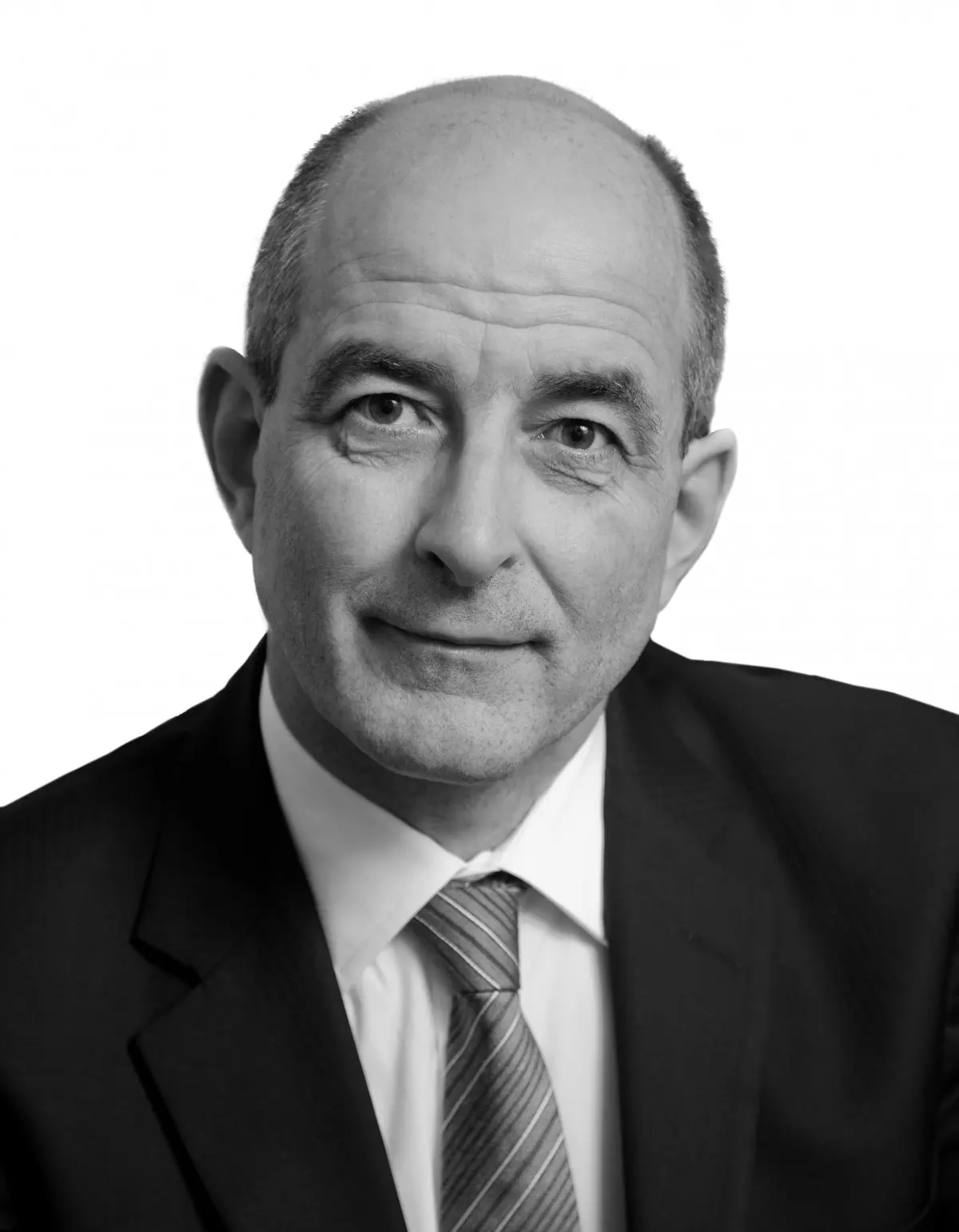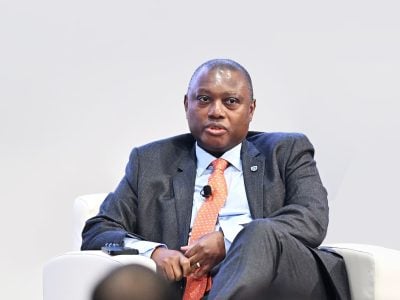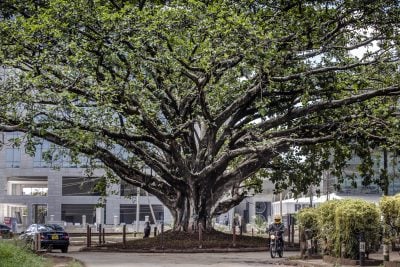The effects of the war in Ukraine and the struggle to deal with debt and restore momentum after Covid-19 cut growth in the African continent as a whole to 3.8% in 2022, down from 4.8% in 2021. However, the big banks continue to flourish despite challenges from new competition and technological change.
South Africa, Egypt, Morocco and Algeria remain the homes of Africa’s banking giants. South Africa’s Standard Bank Group remains an unassailable number one on our ranking of Africa’s Top 100 Banks in 2023 with a formidable lead over National Bank of Egypt (#2) and compatriot Banque Misr (#3).
The ranking is determined by Tier 1 capital (see Methodology below). Standard Bank scores $13.2bn, compared to $7.3bn and $7.2bn for its rivals. Standard Bank’s capital slid back from $13.6bn, partly due to a 6% decline in the South African rand against the US dollar. The Egyptian banks are still ranked on the basis of December 2021 numbers and exchange rates between the Egyptian pound and the dollar.
Standard Bank reigns supreme on other measures – including profits, which climbed $560m from last year to $2.3bn. Total assets fell back a little to $169.9bn (from $170.9bn) when translated into US dollars. National Bank of Egypt scored $167.4bn in 2021. Return on equity (ROE) at Standard Bank was 18% in December 2022, up from 13% the year before. Banque Misr scored profits of $1.5bn and ROE of 21%.
Nedbank climbs to rank #4 in 2023 with Tier 1 capital slightly up to $5.9bn, climbing from rank #7 in 2022 with capital of $5.1bn, after falling back from #5 in 2021. It edges past FirstRand, which is now #5. FirstRand, with Tier 1 capital of $5.5bn, was the second-biggest generator of net profit at $1.6bn (up from $1.4bn) for ROE of 29%, ahead of all the other top-10 banks.
Absa Bank slips back from #6 to #7, with Tier 1 capital of $5.3bn, displaced by Morocco’s Attijariwafa Bank, which continued its slide in the table – down from #5 last year and #4 in 2021, as its Tier 1 capital slid from $5.9bn in the June 2021 figure used for last year’s ranking to $5.4bn for December 2022. (The Moroccan dirham slid back 11% against the US dollar in 2022).
Morocco’s Banque Centrale Populaire continues to hold the #8 position and Banque Extérieure d’Algérie and Banque Nationale d’Algérie are back at #9 and #10, after dropping out of the top 10 ranking in 2022. This year they displace Egypt’s Commercial International Bank (CIB), which fell to #16 from #9 in the 2022 ranking; and Morocco’s Bank of Africa – BMCE Group, which slips to #11. The CIB fall is partly due to its ranking being based on relatively recent results published in December 2022 and translated into dollars after a 36% decline in the Egyptian pound.
Read our regional focuses
- North Africa’s Top Banks in 2023
- East Africa’s Top Banks in 2023
- West and Central Africa’s Top Banks in 2023
- Southern Africa’s Top Banks in 2023
The ranking rules
Some of the shuffling at the top is linked to the structure of the survey rather than the banks’ performance. As in previous years, the banks are ranked according to the Tier 1 capital reported in their latest financial results, published in the banks’ local currencies and converted into US dollars at the date of the reported figures, or 31 December. Tier 1 capital is a primary measure of financial health and represents a bank’s primary funding source, including shareholders’ equity and retained earnings. It includes most of the accumulated funds that buffer banks against shocks.
Most African currencies fell back against the resurgent US dollar during 2022. For example the South African rand slid over 6%, while the Nigerian naira and the Kenyan shilling fell 8%. The recent depreciation of the naira to bring it in line with the parallel rate will have a significant impact on the USD performance of Nigerian banks in their 2023 results.
Related articles
The Egyptian banks at #2 and #3 in our table are ranked on figures from June 2021 (NBE) and December 2021 (Banque Misr) and exchange rates in effect at the time. Had the 2022 Egyptian pound value been used for the ranking it could have shuffled the Egyptian banks lower than Nedbank, which is ranked on its December 2022 figures (and exchange rates) and FirstRand, ranked on June 2022 figures.
In contrast, Egypt’s Commercial International Bank (CIB) is down from #9 to #16, with Tier 1 capital of $2.1bn in December 2022, down from $3.6bn in 2021; and QNB Alahli falls to #20, with Tier 1 capital down to $1.8bn using year-end figures from December 2022, compared to its 2022 ranking at #15 based on Tier 1 capital of $2.5bn published in December 2020.
Other rankings also include development finance institutions and multilateral banks, but we do not include these in our ranking. For instance, giant Afreximbank, also based in Egypt, might rank #5 based on its Tier 1 capital.
Banking in a hostile environment
The steadiness of capital and continuing growth in profits and assets at Africa’s banks shows their strength and their expertise in weathering storms, as many of the economies in which they operate are struggling with unsustainable debt, soaring food import bills, foreign exchange shortages, and poverty for many.
According to the African Development Bank’s African Economic Outlook 2023, “African countries are dealing with multiple shocks, including the effects of the Covid-19 pandemic, disruptions to global supply chains due to Russia’s prolonged invasion of Ukraine and a tightening of global financing conditions… However, African economies remain resilient, with average growth (GDP growth after considering inflation) projected to stabilise at 4.1% in 2023–24.”
Climbing profits
By 2022 banking revenues across Africa had recovered and were above the levels before the pandemic, according to consultants McKinsey. On the positive side are “sustained volume increases, higher interest rates, and stable risk costs”. In many countries, central banks have been raising indicative interest rates as they try to rein in inflation. This usually means bigger net interest margins for banks, partly because they may increase rates demanded from borrowers faster than they boost the rates they pay to savers.
Profitability stars among the top 100 banks are Egypt’s CIB, South Africa’s Capitec Bank (up three spots to #19) and Tanzania’s CRDB Bank (up to #55) – each offering ROE of 31%. Credit Agricole Egypt (down to #80) scores 32%. State-owned Commercial Bank of Ethiopia (#30) has 33% ROE, Ethiopia’s Awash International Bank SC (up at #82) offers 34%; and Tanzania’s National Microfinance Bank (#50) 34%. Angolan banks score highest on ROE: Banco Angolano de Investimentos (climbing to #53) at 51% and Banco de Fomento Angola (down to #56) at 59%.
McKinsey says the longer-term picture is negative, with declining profits and ROE in four of the five biggest banking markets – Egypt, Kenya, Morocco and South Africa – since 2016. Only Nigeria has shown gains.
The average cost-to-asset ratio at the banks is between 4% and 5%, according to McKinsey – almost twice the global average. Costs include large branch networks and legacy computer systems, some built and set up in the 1970s – a problem shared with many global banks. Banks also face downward pressure on profits as alternative providers of digital financial services bring new competition and push down fee margins and income. Three banks in the table show net losses (Arab Tunisian Bank, Ghana Commercial Bank and Absa Bank (Ghana). This compares to Arab Tunisian Bank being the only loss-maker in the 2022 ranking.
Regulatory frontiers continue to widen, including rules on capital; new environmental, social and governance concerns; and ever-tighter efforts against money laundering. The requirement not just to “know your customer” but sometimes to “know your customer’s customer” led some global banks to withdraw entirely from some African countries rather than face fines at head offices in New York or London. For African banks such rules mean higher costs and tighter constraints; and sometimes they feel that the playing field on which they meet their fintech challengers is not even. Fintechs have, however, not entirely escaped: regulators are starting to look harder at them and have frozen accounts at one or two fintech firms accused of lax controls against money-laundering.
Total Tier 1 capital for all the top 100 banks, measured in US dollars, is down 6.24%, compared to the 2022 ranking, and total assets are down 1.25%. The Tier 1 capital required to reach the top 100 table was $226m at Algeria’s BNP Paribas El Djazaïr (#100) this year, compared to last year when Arab Tunisian Bank, ranked #100, had $255m in Tier 1 capital.
Challengers
Analysis by banking consultants at EY (Ernst & Young) says the banks are “caught in the winds of digital transformation and ever-increasing customer expectations”. In the biggest market, South Africa, modern banks and fintech companies are emerging as potent challengers, although none have yet reached the top 100 ranking.
Across Africa, billions of dollars of venture capital and other funding is pouring into fintech solutions, many making news with stunning success fuelling growth, e-commerce and transformation. A few former darlings have also hit the headlines for problems with governance and transparency.
To respond to the challengers, banks need capacity to add new products much faster than before, and need to cultivate an agile and responsive approach to seizing opportunities. Banks are also looking at new partnerships, working with fintech firms that can provide parts of new payment or other systems.
Which country is best for banks?
South Africa and Egypt dominate both the top 10 and the top 100 rankings. Egypt contributes 21 of the top 100 banks, 22.5% of the Tier 1 capital and 27.8% of the total assets of the banks in the ranking. South Africa, by comparison, contributes 26.8% of the Tier 1 capital and 29.6% of the total assets; even though it only has six banks in the ranking, all are within the top 20.
Nigeria is the country with the third-largest contribution to the ranks of banks, with 13 banks in the top 100, 11.8% of Tier 1 capital and 10.6% of total assets (measured in US dollars). Other strong banking countries are Kenya, with 10 banks, and Morocco and Tunisia with 8 each. The rise of East African banks, now taking up 19 of the top 100, up from 14 last year, shows a marked regional swing. These banks contribute 7.7% of the Tier 1 capital, up from 6.5% in 2022.
Race for space
Banks from several centres are racing to seize space and grow customer numbers and profits by expanding across the continent. South Africa’s giants have long been the leaders. Standard Bank Group (#1) subsidiaries in the top 100 are the banks in Nigeria (Stanbic IBTC climbs to #33), Mozambique (#60), Uganda (#70) and Kenya (#72). Absa Bank, in Ghana at #93 and in Kenya at #64, highlights the scale in key markets. Ecobank Group (#17) includes banks in Nigeria (#41) and Ghana (#74).
Morocco’s banks have been extending, especially across western and francophone Africa including Bank of Africa (#11), which operates in 18 other countries. Nigeria’s Access Bank (up to #13 from #16) has subsidiaries in 13 countries spread across the continent. Kenya’s Equity Bank (#23) operates in six other countries, including expanding operations in the Democratic Republic of Congo (DRC), where it has bought and combined two banks to become the country’s second-biggest lender by assets. KCB of Kenya took a controlling stake in DRC’s Trust Merchant Bank.
Smaller banks are also considering cross-border expansion. In July 2023 Mustafa Rawji, CEO of DRC’s Rawbank, said: “We are considering acquisitions of banks in neighbouring countries where there is a strategic sense to the acquisition to leverage on our existing customer base.”
There may be opportunities as international banks such as Standard Chartered, Barclays and Atlas Mara divest themselves of African banking operations. Uganda’s Centenary Rural Development Bank has won a banking licence in Malawi.
Challenger banks such as Kenya’s Equity Bank (#23 overall, #1 in East Africa) have risen to the top after decades of seizing an opportunity neglected by some of the previous establishment banks that preferred to focus on bigger businesses and wealthier customers: people who are unbanked or underbanked. There are many more chances to seize this opportunity – some studies estimate that one out of every two Africans, some 730m people, still cannot access suitable banking services.
Rising stars
One high-climbing new entrant to our rankings is Egypt’s First Abu Dhabi Bank Misr, debuting at #34 with Tier 1 capital of $777m at December 2022 and assets of $8.3bn. It is one of the largest foreign banks operating in Egypt and was formed after the June 2022 completion of a merger between 45-year-old First Abu Dhabi Bank Egypt and Bank Audi Egypt (last year #64 on the ranking, and the Egyptian arm of a Lebanese bank). Hana Al Rostamani, Group CEO of FAB, the largest bank in the UAE, said the merger “… will enable us to further extend our operations’ footprint in Egypt—one of the most promising strategic markets in the region”. The bank has a new brand identity as FABMISR and operated 69 branches in March 2022.
Société Générale Côte d’Ivoire bounces back at #63 with Tier 1 capital of $410m based on its December 2021 results, after dropping to #97 in the 2020 ranking and failing to make the top 100 for two years. Its share price on the Bourse Régionale des Valeurs Mobilieres (BRVM) has climbed sharply this year. Société Tunisienne de Banque (STB) is back at #67 after being ranked #77 in 2021 and missing the top table last year.
Al Baraka Bank Egypt was just outside the top 100 last year at #102 with Tier 1 capital of $241m based on December 2020 results and this year climbs to #79 as Tier 1 capital in December 2021 was $310m.
Dashen Bank in Ethiopia joins the ranking at #86 with Tier 1 capital of $282m, based on June 2022 results. It boosts its country’s participation in the top ranking to three banks from two, despite the headwinds of a managed 8% decline in the birr against the US dollar during 2022.
Africa's Top 100 Banks in 2023
Methodology
The Top 100 Banks survey ranks the banks according to their Tier 1 capital, which is made up of capital + reserves + retained earnings + minority interests.
We collect data from Bankers’ Almanac and from in-house research at African Business. The banks publish their figures in local currencies and the research team converts them into US dollars ($) at the exchange rates at the date of the results (or on 31 December). Changes in the exchange rates therefore affect the rankings. We have excluded some banks for which data is old or unreliable.
Three banks have been consolidated at group level, where their results include assets outside their principal country. Standard Bank South Africa would by itself be the third biggest in our rankings, with Tier 1 capital of $6.4bn, assets in excess of $100bn and profits in excess of $1bn. Kenya Commercial Bank would by itself be Kenya’s biggest bank with capital of $718m, assets of $7.9bn and profits of $281m. Equity Bank Kenya has capital of $520m, assets of $7.2bn and profits of $271m.
Development finance institutions
African development finance institutions (DFIs) are increasingly playing an important role across a number of sectors. We also see an increasing role for Guarantee Funds and the like in increasing lending to underserved communities and sectors – such as women, as well as the small and medium enterprise (SME) and agriculture sector. African DFIs have grown their balance sheets considerably over the past few years. As governments are fiscally constrained, DFIs are expected to play an even bigger catalytic role in strategic areas such as infrastructure and the energy transition.
The Arab Bank for African Economic Development (BADEA) has recently increased its capital to nearly $5.5bn. With a loan book in the same region, the bank has much scope for growth.
The African Export Import Bank (Afreximbank) has grown its balance sheet rapidly over the past decade: today it stands at $30bn, with still larger ambitions. Its capital has also increased to nearly $5bn, with plans for further growth. In 2022, it posted profits of $455m. Depending on which metric is used, Afreximbank would feature in the Top 10 or Top 15 of our rankings.
The African Development Bank has assets in excess of $40bn and over $200bn of callable capital, making it Africa’s largest DFI. There are other important regional players. The Eastern and Southern African Trade and Development Bank (TDB) has grown its balance sheet to over $8bn, from under $5bn five years ago, posting healthy profits of over $200m in 2022. Another silent giant is the Development Bank of Southern Africa (DBSA). It has capital of $2.7bn and assets of $6.9bn – which shows room for growth – and posts strong results with net profits of $264m.
The interventions of DFIs are proving vital for the continent and will only increase in coming years.
Want to continue reading? Subscribe today.
You've read all your free articles for this month! Subscribe now to enjoy full access to our content.
Digital Monthly
£8.00 / month
Receive full unlimited access to our articles, opinions, podcasts and more.
Digital Yearly
£70.00 / year
Our best value offer - save £26 and gain access to all of our digital content for an entire year!

 Sign in with Google
Sign in with Google 



